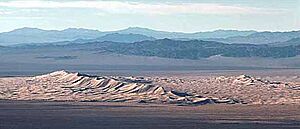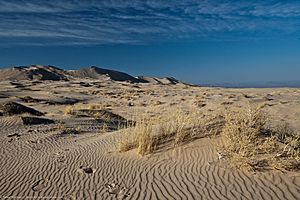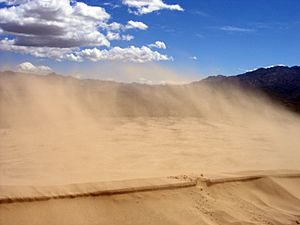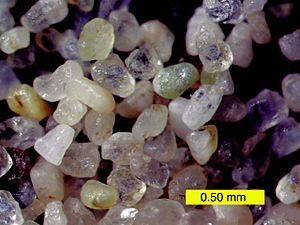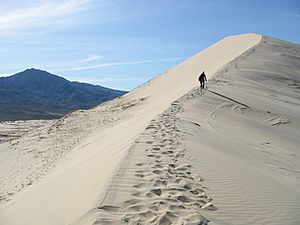Kelso Dunes facts for kids
The Kelso Dunes, also known as the Kelso Dune Field, is the biggest area of wind-blown sand in the Mojave Desert. This amazing place is protected within the Mojave National Preserve. You can find it close to Baker, in San Bernardino County, California. It's also near the Preserve Visitor Center.
This huge area of sand covers about 45 square miles (117 square kilometers). It has different kinds of dunes, like those that move and those held in place by plants. There are also flat areas of sand and sandy slopes. The tallest dunes here are super tall, rising up to 650 feet (198 meters) above the land around them!
Contents
What are the Kelso Dunes Made Of?
The sand at Kelso Dunes is mostly light-colored quartz and feldspar. These tiny pieces probably came from granite rocks in the San Bernardino Mountains to the southwest. Over time, wind and water broke down these rocks into sand. You can also find darker minerals like magnetite and amphibole here. These often gather at the very tops of the dunes.
The Kelso Dunes are part of a much larger system where sand moves around. This system includes the nearby Devils Playground area. Scientists believe most of the sand came from the Mojave River sink, near a place called Afton Canyon]. This area is west of where the dunes are now. The sand piled up at the southeastern end of the Soda Lake-Kelso basin. This happened because the Granite Mountains and Providence Mountains blocked the strong winds. Today, new sand is not really building up at Kelso Dunes anymore.
Singing Sand and How the Dunes Formed
The Kelso Dunes are famous for something special called "singing sand" or "booming dunes." When people climb to the top and slide down slowly, the sand makes a low rumbling sound. You can both hear and feel this sound! This cool effect also happens at other places, like the Eureka Dunes in California and Sand Mountain in Nevada. The sound is much louder when the sand is very dry.
The Kelso Dunes are made of five layers of dunes stacked on top of each other. Each layer formed during a different period of climate change over the last 25,000 years. When the climate was dry, there were fewer plants to hold the sand in place. This allowed the wind to blow the sand to the dunes. For example, much of the eastern part of the Kelso dunes formed when nearby Soda Lake and Silver Lake dried up into their current playas (dry lakebeds). After the sand settled, plants started to grow, which helped to keep much of it from moving again.
Visiting the Kelso Dunes
You cannot drive vehicles on the Kelso Dunes. However, they are completely open for hikers to explore! The path to the dunes starts at the end of a three-mile (5 km) dirt road. This road branches off from Kelbaker Road. You can get to Kelbaker Road from either Interstate 15 (near Baker) or Interstate 40 (east of Barstow). The dunes are just southwest of the Kelso ghost town and the Park's Visitor Center at the historic Kelso Depot.
Animals and Plants of the Kelso Dunes
Like many other sand dune areas in southern California, the Kelso Dunes are home to special animal species found nowhere else. These are called endemic species. Scientists have found at least ten types of insects that live only here. Some examples include:
- The Kelso giant sand treader cricket (Macrobaenetes kelsoensis)
- The Kelso Jerusalem cricket (Ammopelmatus kelsoensis)
- A rare Mydas fly called Rhaphiomidas tarsalis
- The Kelso shieldback katydid (Eremopedes kelsoensis)
While not strictly endemic, some plant and reptile species are very rare outside of these dunes. One interesting example is the Mojave fringe-toed lizard (Uma scoparia). This lizard is amazing because it can "swim" under the sand to move around!
Images for kids


